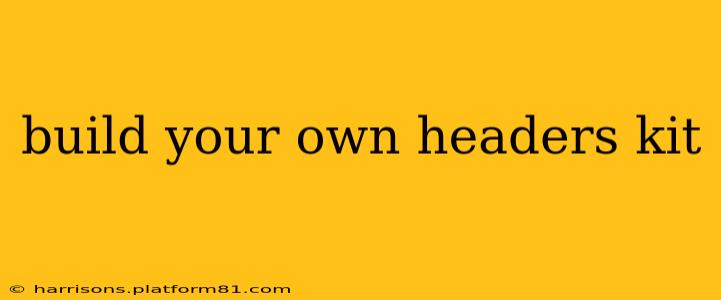Build Your Own Headers Kit: A Comprehensive Guide
Building your own headers kit allows for unparalleled customization and control over your projects. Whether you're a seasoned DIY enthusiast or a beginner just starting out, this guide will walk you through the process, equipping you with the knowledge and confidence to tackle this rewarding endeavor. We'll cover everything from choosing the right materials and tools to mastering the installation process.
Why Build Your Own Headers?
Before diving into the specifics, let's explore the compelling reasons behind crafting your own headers:
- Customization: The most significant advantage is the ability to perfectly tailor your headers to your specific needs and aesthetic preferences. You can choose from a vast array of materials, styles, and finishes to achieve a truly unique look.
- Cost Savings: While the initial investment in tools and materials might seem significant, building your own headers can often prove more cost-effective in the long run, especially for larger projects.
- Quality Control: When you build your own headers, you have complete control over the quality of materials and construction techniques, ensuring a durable and long-lasting product.
- Satisfaction: There's a profound sense of accomplishment that comes with creating something tangible and functional with your own two hands.
What Materials Will You Need?
The materials you'll need will depend heavily on the type of headers you're building and your desired aesthetic. However, here's a general list to get you started:
- Wood: This is a popular choice for its versatility, strength, and aesthetic appeal. Consider using hardwoods like oak or maple for superior durability. Softwoods like pine are more budget-friendly but may require more care.
- Fasteners: You'll need screws, nails, or other suitable fasteners to secure the header components together. Choose fasteners that are appropriate for the type of wood you're using.
- Adhesives: Wood glue is essential for reinforcing joints and ensuring a strong, stable header.
- Finishing Materials: Once the header is assembled, you'll need to finish it to protect it from the elements and enhance its appearance. Options include paint, stain, varnish, or polyurethane.
- Measuring and Cutting Tools: Accuracy is crucial, so invest in a quality measuring tape, saw (hand saw or miter saw), and possibly a planer for smoothing the wood.
- Safety Gear: Always prioritize safety! Wear safety glasses, hearing protection, and work gloves throughout the project.
Step-by-Step Guide to Building Your Headers
While specific steps will vary based on design complexity, the general process involves these key stages:
- Planning and Design: Sketch your header design, noting dimensions, materials, and joinery techniques. Consider the overall style of your project and choose a design that complements it.
- Cutting the Wood: Accurately cut the wood pieces to your planned dimensions. Take your time and ensure precise measurements to avoid errors.
- Assembling the Header: Join the cut pieces together using appropriate joinery techniques (e.g., miter joints, butt joints) and secure them with screws, nails, and wood glue. Clamps can help ensure a strong bond.
- Sanding and Finishing: Once the glue is dry, sand the header smooth to remove any imperfections or rough edges. Then, apply your chosen finish to protect and enhance the appearance of the wood.
- Installation: Carefully install the header in its intended location, ensuring it's securely fastened and level.
What are the different types of header designs?
Header designs can vary widely depending on the architectural style and the load-bearing requirements. Common types include:
- Simple Rectangular Headers: These are the most basic design, suitable for smaller openings and non-load-bearing applications.
- Arched Headers: These create a more elegant and decorative look, often found in traditional or ornate styles.
- Segmental Arch Headers: A variation of the arched header, they offer a flatter arch, making them suitable for certain applications where a full arch isn't feasible.
- King Post Trusses: Used for larger openings or load-bearing applications, these involve a central vertical post supporting the header.
What tools do I need to build a header?
The necessary tools depend on the complexity of the header, but generally include:
- Measuring Tape: For accurate measurements.
- Saw (Hand Saw or Miter Saw): For cutting the wood.
- Drill: For pilot holes and driving screws.
- Screwdriver: For fastening screws.
- Clamps: To hold the pieces together while the glue dries.
- Sandpaper: For smoothing the wood.
- Safety Glasses and Gloves: For personal protection.
This guide provides a foundational understanding of building your own headers kit. Remember to consult with a professional if you are unsure about any aspect of the project, particularly if it involves load-bearing structures. Happy building!
